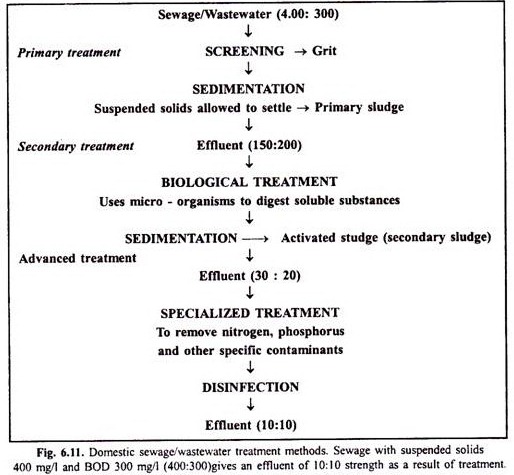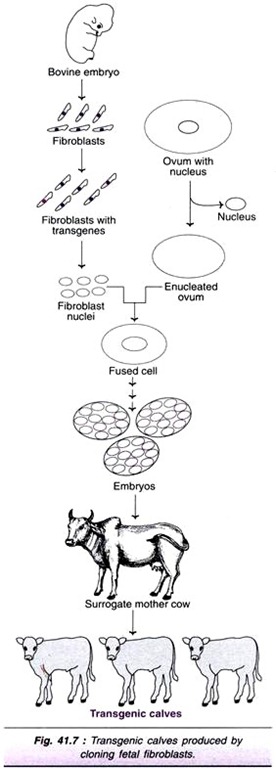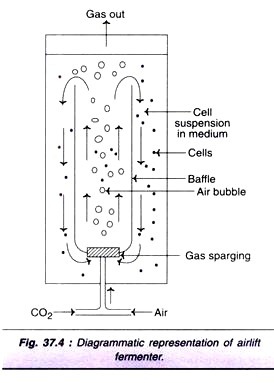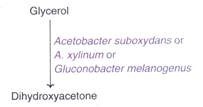Read this article to learn about the manipulation of gene expression in prokaryotic host cells and eukaryotic host cells.
Contents
Selection of Host Cells for Gene Expression:
The nature of a host cell or an organism is as important as the nature of a vector.
The most important requirements of a good host include its suitable cultivation in the laboratory, besides incorporating the vector’s genetic material. Several prokaryotes and eukaryotes are employed as hosts to express foreign genes.
Prokaryotic Hosts:
The bacterium Escherichia coli was the first organism to be used in recombinant DNA technology experiments, and continues to be a host of choice for commercial production of proteins. The extensive use of E. coli is mainly due to its high rate of reproduction (the cells double in number, every twenty minutes), besides good knowledge on its biochemistry, physiology and molecular biology.
There are a few disadvantages also in using E. coli as a host. These include a relatively poor export system for proteins and the production of endotoxins which are often difficult to remove (from other useful products). The other host bacterium in use is Bacillus subtilis. This organism is widely employed for commercial production of antibiotics, industrial enzymes, insecticides etc.
Eukaryotic Hosts:
It is often desirable to use eukaryotic organisms, with a well-defined nucleus and cellular organelles, as hosts. The main advantage with eukaryotes is that they bring about several post-translational modifications to make viable and functional proteins. Further, use of eukaryotic hosts is not associated with the generation and interference of toxins which is the case with some prokaryotes. Thus, eukaryotic gene expression systems are preferred for the production of proteins and therapeutic agents that are useful for humans and animals.
The yeast Saccharomyces cerevisiae is widely used as a host for the expression of cloned eukaryotic genes. The other yeasts in use include Kluveromyces lactis, Schizosaccharomyces pombe and Picha pastoris. The insect cells which are infected by baculovirus are in use as hosts in recent years. The baculovirus system can carry and express hundreds of genes in insect cells. Another advantage is that the safety factor since baculoviruses does not infect humans, other vertebrates or plants.
Mammalian cells such as mouse cells can be used as hosts to produce complex proteins with optimal biological functions. But the limitations with mammalian cells are that the techniques are tedious, often difficult, and also expensive. The manipulation of gene expression, as it is carried out, in prokaryotic and eukaryotic cells.
Manipulation of Gene Expression in Prokaryotes:
The prime objective of gene cloning is to finally result in the large scale production of proteins for a variety of purposes (industrial, commercial, human health and welfare). This is achieved by the maximal expression of cloned genes through manipulations.
The following are the important features of gene expression that can be considered for manipulation:
i. The presence of regulatable promoters.
ii. The number of copies of cloned genes.
iii. The location of the cloned genes whether inserted into a plasmid or integrated into host genome.
iv. The translation efficiency of the host.
v. The cellular location of the foreign protein and its stability in the host cell.
Some of the strategies that are employed for the manipulation of gene expression in E. coli are discussed hereunder.
Regulatable promoters:
The presence of a strong regulatable promoter sequence is essential for an effective expression of a cloned gene. This is achieved by employing the promoters of E. coli lac (lactose) operon or trp (tryptophan) operon. These promoters have strong affinity for RNA polymerase, and consequently the downstream region (of cloned gene) is transcribed. The promoters thus provide a switch for turning on or turning off the transcription of a cloned gene.
Fusion proteins:
The combination of a foreign protein (encoded by a cloned gene) with the host protein is referred to as a fusion protein. In general, the foreign proteins synthesized are rapidly degraded. This can be reduced by covalently linking a stable host protein to the foreign proteins (i.e., fusion proteins).
The fusion proteins in fact protect the proteolytic degradation of cloned gene product. The synthesis of fusion proteins is achieved by ligating the coding sequences of two genes (cloned gene and host gene). However, it is absolutely essential to ensure that cloned gene contains the correct sequence for the synthesis of the target protein.
Cleavage of fusion proteins:
The fusion proteins, as such, interfere with the biological activity of the target protein. Therefore, these proteins should be cleaved to release the specific desired functional proteins.
Uses of fusion proteins:
The purification of recombinant proteins is much easier in the form of fusion proteins. Fusion proteins are also useful for generating antibodies against target proteins.
Tandem gene arrays:
In general, increase in the number of plasmids (containing cloned gene) proportionately increases the production of recombinant protein. This has a drawback. As the plasmid number increases, the genes coding for antibiotic resistance also increase. The overall effect is that the regular metabolic activates of the host cell are disturbed for the synthesis of plasmid proteins. Consequently, the yield of cloned gene product is not optimum.
An alternative approach is to clone multiple copies of the target gene on a single plasmid (instead of a single gene on a plasmid). In this manner, tandem arrays of a gene can be created. However, each sequence of the genes should be in correct orientation for transcription and translation.
Efficiency of translation:
The quantity of the cloned gene product produced depends on the efficiency of translation. In general, the binding ability of mRNA with the ribosomal RNA, at translational initiation signal called ribosome binding site determines translation. Thus, the efficiency of translation is better if the binding of mRNA to rRNA is stronger. The actual binding between mRNA and rRNA occurs by complementary base pairing of a sequence of 6-8 nucleotides. To achieve maximum translation, the E. coli expression vectors are designed to possess a strong ribosome binding site.
Stability of proteins:
The half-lives of recombinant proteins are highly variable, ranging from minutes to hours. The stability of proteins can be increased by adding amino acids at the N-terminal end of the proteins. Thus, by attaching methionine, serine and alanine to the N-terminal end, the half-life of β-galactosidase can be increased from 2 minutes to 20 hours! Frequently, a single amino acid addition at N-terminal end stabilizes the protein. The yield of recombinant DNA proteins can be enhanced by increasing half-lives.
Secretion of proteins:
The stability of a protein and its secretion are interrelated. An amino acid sequence (signal peptide) may be attached to a protein to facilitate its secretion through cell membrane. Recombinant proteins secreted into the growth medium can be easily purified.
Integration of cloned DNA into the host chromosome:
The use of plasmids for transcription and translation of cloned DNA imposes a metabolic load on the host. In addition, there is often a chance of losing plasmids during cell multiplication. These problems can be overcome by integrating the cloned DNA directly into host chromosomal DNA. Once the cloned DNA becomes a part of genome, it can be maintained for several generations.
Cloned DNA integration into the host DNA is possible only when there is a complementary sequence of about 50 nucleotides between them. The exchange of DNAs occurs by a recombination process (Fig. 11.1). The cloned DNA lies in the middle of plasmid DNA. On physical contact with chromosomal DNA, base pairing occurs between plasmid DNA (x and y) and chromosomal DNA (x’ and y’). And the cloned DNA is transferred to host chromosomal DNA by a physical exchange i.e., recombination.
Metabolic load:
The presence of cloned DNA alters the metabolism and cellular functions of the host organism. Such metabolic changes are collectively referred to as metabolic load, metabolic drain or metabolic burden. There are several causes for the metabolic load. These include increased utilization of energy for replication and maintenance of plasmids, overproduction of proteins (also drains amino acids, tRNAs), and interference of foreign proteins on the host cell function.
Manipulation of Gene Expression in Eukaryotes:
Expression of cloned genes in eukaryotes has certain advantages. The most important being the ability of eukaryotic organisms to bring about post-translational modifications—glycosylation, phosphorylation, correct disulfide bond formation, proteolytic cleavage etc. Eukaryotic expression systems produce stable and biologically active proteins. This is in contrast to the prokaryotic expression of cloned genes.
In general, the eukaryotic expression of cloned genes is quite comparable to that occurs in the prokaryotes. However, from the technical perspective, it is more difficult to conduct experiments with eukaryotic cells. Many a times, vectors with two distinct origins of replication are used. They serve as shuttle vectors and function in prokaryotic as well as eukaryotic hosts.
The insertion of a foreign DNA into bacterial and yeast cells is referred to as transformation The term transfection is used for the introduction of a foreign DNA into animal cells. The insert DNA in the eukaryotic cells may be associated with vector or integrated into the host chromosomal DNA.
Saccharomyces Cerevisiae— The Yeast in Expressing Cloned Genes:
The common yeast Saccharomyces cerevisiae is widely used as a host for the expression of cloned genes. There are many justifiable reasons for its extensive use.
i. S. cervisiae is single-celled that can be easily grown. Its biochemistry, genetics and physiology are quite known.
ii. It has a naturally occurring plasmid and strong promoters for efficient expression.
iii. S. cerevisiae can bring about many postradiational changes in proteins.
iv. The secreted recombinant proteins can be easily isolated, since very few host proteins are secreted.
v. The U.S. Food and Drug Administration has certified S. cerevisiae as a generally recognized as a safe (CRAS) organism.
As such, S. cerevisiae has been in use for several decades in baking and brewing industries. Biotechnologists work quite comfortably with this yeast to produce a large number of recombinant proteins. These include insulin, a1 -antitrypsin, hepatitis B virus surface antigen, platelet derived growth factor, fibroblast growth factor and HIV-I antigens. These products are in use as diagnostic agents, vaccines, and therapeutic agents.
Vectors for S. cerevisiae:
There are three types of vectors for S. cerevisiae:
1. Episomal or plasmid vectors.
2. Integrating vectors.
3. Yeast artificial chromosomes (YACs).
1. Plasmid vectors:
Among the vectors, plasmids with single cloned genes are widely used. Manipulation with growth conditions increase the vector stability and expression efficiency. Use of tandem gene arrays has not met with success, since they are unstable.
2. Integrating vectors:
They are basically the integration of cloned genes with chromosomal DNA. These are not frequently used, since the protein production is low.
3. Yeast artificial chromosome (YAC):
Introduced in 1987, YAC is a fragment of yeast DNA that will accept a foreign DNA of about 250-500 kb in length. In fact, the yeast DNA is only about 1% of the total DNA which however, is very important, since it contains three essential genes required for replication. These are the genes for telomere (that protects DNA from nuclease degradation and thus maintains stability), centromere (forms spindles during cell division) and the origin of replication (where DNA polymerase initiates replication). YAC behaves just like a chromosome and replicates.
The construction of the yeast artificial chromosome is depicted in Fig. 11.2. Two opposite ends of a yeast chromosome namely the left telomere and right telomere are chosen. The left telomere is then attached to a centromere. A large segment of the foreign DNA is added and all the three are ligated. Unlike the plasmid vectors, the stability of YAC increases as the size of insert DNA increases.
YACs have not been used for commercial production of recombinant proteins. However, they have been employed successfully for physical mapping of genomic DNAs, particularly in human genome project.
Post-translational modifications by S. cerevisiae:
The heterologous proteins synthesized by S. cerevisiae undergo post-translational changes while they are being exported into the extracellular environment. To facilitate protein secretion, a single (leader) peptide is attached to the protein. This peptide is removed by the yeast endoprotease.
Other Yeast Expression Systems:
Despite the very successful use of S. cerevisiae for generating recombinant proteins, there are certain limitations. These include a very low or a limited yield, difficulty in secretion of some proteins and hyper glycosylation. Attempts are being made to explore the utility of other yeasts for the production of hepatitis B virus surface antigen (HBsAg) and bovine lysozyme. The yeast, Hansenula polymorpha, is employed for the synthesis of α- and β-globin chains of human hemoglobin.
Insect Cell Expression Systems:
Cultured insect cells are in use for expressing cloned DNAs. Baculo viruses exclusively infect insect cells. The DNA of these viruses encode for several products and their productivity in cells is very high to the extent of more than 10,000 times compared to mammalian cells. Besides carrying a large number of foreign genes, the baculoviruses can effectively express and process the products formed. Another advantage with these viruses is that they cannot infect humans, other vertebrates or plants. Thus, baculoviruses are safe vectors.
Polyhedrin gene of baculovirus:
The polyhedrin gene is responsible for the synthesis of a matrix protein-polyhedrin. This protein is synthesized in large quantities by baculovirus during the infection cycle. Polyhedrin protects the virus from being inactivated by environmental agents. The promoter for polyhedrin gene is very strong. However, the life-cycle of baculovirus does not depend on the presence of this gene. Polyhedrin gene can be replaced by a cloned gene, and the genetically engineered baculovirus can infect the cultured insect cells.
The cloned gene expresses, and large quantities of recombinant proteins are produced. Because of a close similarity in the post-translational modifications between insects and mammals, biologically active proteins can be produced by this approach. And in fact, by using baculovirus as an expression vector system, a good number of mammalian and viral proteins have been synthesized (Table 11.1).
Baculovirus expression vector system:
The most commonly used baculovirus is Autograph California multiple nuclear polyhedrosis virus (AcMNPV). It can grow on the insect cell lines (e.g., derived from fall army worm) and produce high levels of polyhedrin or a recombinant protein. The organization of a baculovirus (AcMNPV) transfer vector is shown in Fig. 11.3A. It consists of an E. coli-based plasmid vector along with the DNA of baculovirus. This in turn has AcMNPV DNA, a polyhedrin promoter region, cloning site for insert DNA and polyhedrin termination region.
When the insect culture cells, transfected with AcMNPV are mixed with transfer vector carrying a cloned gene, a double crossover occurs. The result is that the cloned gene with polyhedrin promoter and termination sequences gets integrated into AcMNPV DNA (Fig. 11.3B). In this process, polyhedrin gene is lost. The recombinant baculovirus containing cloned gene is isolated.
The host insect culture cells, on infection with recombinant baculovirus, produce heterologous proteins. A large number and a wide variety of recombinant proteins (around 500) have been synthesized in the laboratory. A majority of them (>95%) have the requisite post-translational modifications. A selected list of recombinant proteins is given in Table 11.1.
Modifications in the production of recombinant baculovirus:
The original method of creating recombinant baculovirus has undergone several changes. Incorporation of a unique Bsu 361 restriction endonuclease site on the polyhedrin gene increases the yield of recombinant baculovirus production to about 30% from the normal 1%.
Bacmid:
This is shuttle vector for E. coli and insect cell baculovirus. Construction of a recombinant bacmid is a novel approach to carry out all the genetic manipulations including the expression of baculovirus vector in E. coli.
Use of yeast cells:
The genetic manipulations of AcMNPV genome can be done in yeast cells with yeast-insect shuttle vector. Then the recombinant baculovirus is introduced into insect cells.
Mammalian Cell Expression Vectors:
Mammalian expression vectors are useful for the production of specific and authentic recombinant proteins (for use as therapeutic agents). In addition, they are also helpful for studying the function and regulation of mammalian genes. In general, the mammalian expression vectors are quite comparable to other eukaryotic expression vectors. . However, large-scale production of recombinant proteins with engineered mammalian cells is costly.
A diagrammatic representation of mammalian vector is shown in Fig. 11.4. It contains a eukaryotic origin of replication from an animal virus such as Simian virus 40 (SV40) and a prokaryotic origin of replication (from E. coli). The mammalian vector has a multiple cloning site and a selectable marker gene. Both of them are under the control of eukaryotic promoter and polyadenylation sequences.
These sequences are obtained from either animal viruses (SV40, herpes simplex virus) or mammalian genes (growth hormone, metallothionein). The promoter sequences facilitate the transcription of cloned genes (at the multiple cloning site) and the selectable marker genes. On the other hand, the polyadenylation sequences terminate the transcription. Ampicillin resistant marker gene can be used for selecting the transformed E. coli cells.
Markers for mammalian expression vectors:
There are several markers in use for the selection of transformed mammalian cells. The bacterial gene (Neor) that encodes for neomycin phosphotransferase is frequently used. The other markers are the genes that encode for the enzyme dihydrofolate reductase (DHFR), and glutamine synthetase (GS).




